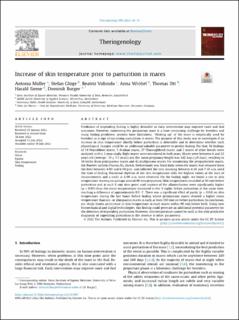Please use this identifier to cite or link to this item:
https://doi.org/10.21256/zhaw-25437Full metadata record
| DC Field | Value | Language |
|---|---|---|
| dc.contributor.author | Müller, Antonia | - |
| dc.contributor.author | Glüge, Stefan | - |
| dc.contributor.author | Vidondo, Beatriz | - |
| dc.contributor.author | Wróbel, Anna | - |
| dc.contributor.author | Ott, Thomas | - |
| dc.contributor.author | Sieme, Harald | - |
| dc.contributor.author | Burger, Dominik | - |
| dc.date.accessioned | 2022-08-11T13:41:35Z | - |
| dc.date.available | 2022-08-11T13:41:35Z | - |
| dc.date.issued | 2022-07-19 | - |
| dc.identifier.issn | 0093-691X | de_CH |
| dc.identifier.issn | 1879-3231 | de_CH |
| dc.identifier.uri | https://digitalcollection.zhaw.ch/handle/11475/25437 | - |
| dc.description.abstract | Prediction of impending foaling is highly desirable as early intervention may improve mare and foal outcomes. However, monitoring the peripartum mare is a time-consuming challenge for breeders and many foaling prediction systems have limitations. "Heating up" of the mare is empirically used by breeders as a sign of upcoming parturition in mares. The purpose of this study was to investigate if an increase in skin temperature shortly before parturition is detectable and to determine whether such physiological changes could be an additional valuable parameter to predict foaling. For that, 56 foalings of 14 Warmblood mares, 5 Arabian mares, 27 Thoroughbred mares, and 2 mares of other breeds were analyzed in this 2-year-study. Eight mares were monitored in both years. Mares were between 4 and 22 years old (average: 10 ± 5.5 years) and the mean pregnancy length was 342 days (±9 days), resulting in 14 births from primiparous mares and 42 multiparous mares. For monitoring the periparturient mares, the Piavet® system (Piavita AG, Zurich, Switzerland) was fixed daily when the mares had returned from the field between 4:00 and 6:00 p.m. and collected the next morning between 6:30 and 7:30 a.m. until the time of foaling. Nocturnal rhythms of the skin temperature with the highest values at the start of measurements and a nadir at 6:00 a.m. were observed. On the foaling night, we found a rise in skin temperature starting on average around 90 min prepartum. Skin temperatures recorded at 50 min before parturition and at each 5 min time point until rupture of the allantochorion were significantly higher (p < 0.05) than the mean temperatures measured in the 5 nights before parturition at the same time, reaching a difference of approximately 0.5 °C. There was a significant effect of parity (p = 0.04) on skin temperature during the last hours before foaling where primiparous mares showed a higher mean temperature than uni- or pluriparous mares as early as from 180 min on before parturition. In conclusion, our study shows an increase in skin temperature in most mares within 90 min before birth. Using new biomechanical and digital technologies, this finding could generate an additional potential parameter for the detection of impending parturition. However, skin temperature cannot be used as the only predictive diagnostic of impending parturition in the absence of other parameters. | de_CH |
| dc.language.iso | en | de_CH |
| dc.publisher | Elsevier | de_CH |
| dc.relation.ispartof | Theriogenology | de_CH |
| dc.rights | http://creativecommons.org/licenses/by/4.0/ | de_CH |
| dc.subject | Equine | de_CH |
| dc.subject | Foaling | de_CH |
| dc.subject | Machine learning | de_CH |
| dc.subject | Skin temperature | de_CH |
| dc.subject.ddc | 006: Spezielle Computerverfahren | de_CH |
| dc.subject.ddc | 590: Tiere (Zoologie) | de_CH |
| dc.title | Increase of skin temperature prior to parturition in mares | de_CH |
| dc.type | Beitrag in wissenschaftlicher Zeitschrift | de_CH |
| dcterms.type | Text | de_CH |
| zhaw.departement | Life Sciences und Facility Management | de_CH |
| zhaw.organisationalunit | Institut für Computational Life Sciences (ICLS) | de_CH |
| dc.identifier.doi | 10.1016/j.theriogenology.2022.07.007 | de_CH |
| dc.identifier.doi | 10.21256/zhaw-25437 | - |
| dc.identifier.pmid | 35932522 | de_CH |
| zhaw.funding.eu | No | de_CH |
| zhaw.originated.zhaw | Yes | de_CH |
| zhaw.pages.end | 51 | de_CH |
| zhaw.pages.start | 46 | de_CH |
| zhaw.publication.status | publishedVersion | de_CH |
| zhaw.volume | 190 | de_CH |
| zhaw.publication.review | Peer review (Publikation) | de_CH |
| zhaw.webfeed | Bio-Inspired Methods & Neuromorphic Computing | de_CH |
| zhaw.webfeed | Predictive Analytics | de_CH |
| zhaw.funding.zhaw | PiaBreed: Machine Learning zur automatisierten Ovulations- und Geburtsüberwachung am Pferd | de_CH |
| zhaw.author.additional | No | de_CH |
| zhaw.display.portrait | Yes | de_CH |
| Appears in collections: | Publikationen Life Sciences und Facility Management | |
Files in This Item:
| File | Description | Size | Format | |
|---|---|---|---|---|
| 2022_Mueller-etal_Increase-skin-temperature-prior-parturition-mares.pdf | 974.43 kB | Adobe PDF |  View/Open |
Show simple item record
Müller, A., Glüge, S., Vidondo, B., Wróbel, A., Ott, T., Sieme, H., & Burger, D. (2022). Increase of skin temperature prior to parturition in mares. Theriogenology, 190, 46–51. https://doi.org/10.1016/j.theriogenology.2022.07.007
Müller, A. et al. (2022) ‘Increase of skin temperature prior to parturition in mares’, Theriogenology, 190, pp. 46–51. Available at: https://doi.org/10.1016/j.theriogenology.2022.07.007.
A. Müller et al., “Increase of skin temperature prior to parturition in mares,” Theriogenology, vol. 190, pp. 46–51, Jul. 2022, doi: 10.1016/j.theriogenology.2022.07.007.
MÜLLER, Antonia, Stefan GLÜGE, Beatriz VIDONDO, Anna WRÓBEL, Thomas OTT, Harald SIEME und Dominik BURGER, 2022. Increase of skin temperature prior to parturition in mares. Theriogenology. 19 Juli 2022. Bd. 190, S. 46–51. DOI 10.1016/j.theriogenology.2022.07.007
Müller, Antonia, Stefan Glüge, Beatriz Vidondo, Anna Wróbel, Thomas Ott, Harald Sieme, and Dominik Burger. 2022. “Increase of Skin Temperature prior to Parturition in Mares.” Theriogenology 190 (July): 46–51. https://doi.org/10.1016/j.theriogenology.2022.07.007.
Müller, Antonia, et al. “Increase of Skin Temperature prior to Parturition in Mares.” Theriogenology, vol. 190, July 2022, pp. 46–51, https://doi.org/10.1016/j.theriogenology.2022.07.007.
Items in DSpace are protected by copyright, with all rights reserved, unless otherwise indicated.